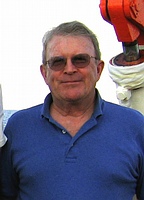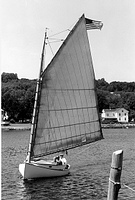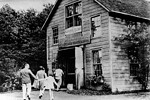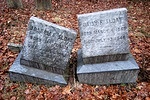HEYHOE KARMA: A Love Story
I was inspired to write the following piece after reading the wonderful article about HeyHoe Woods written by Greta Nettleton in the last issue of 10964. I hope this will add a bit more luster to the mystique of this wonderful HeyHoe Woods Road.
Once upon a time, a long time ago, a young newly minted Columbia University PhD scientist from Kansas, moved with his wife and daughter to Heyhoe Woods, renting Sanderson Vanderbilt’s house towards the end of the road. They loved the privacy and mystery of this unique section of Palisades. The year was 1966. Soon enough the family expanded to include a second daughter and a beagle named Sadie. Life was fine for Dennis Hayes, his wife, Judy, and his two girls Jennifer and Katharine. Elizabeth, their youngest, had not yet been born.
Read more...The Development, Originally Palisades Gardens
In the late 1950s Palisades Gardens, located to the left of Oak Tree Road above Route 340, was built on 50 acres of land that had most recently belonged to Charles Nessler, the inventor of the permanent wave. Originally part of the old Mann farm, the land had been bought in the late 19th century by Floyd Bailey, who built an estate called Valley View. Early in the 20th century Bailey sold the property to the banker James Wallace, who founded the Sparkill Bank, and built an imposing stone wall along the road. Nessler bought the property in the 1920s.
Read more...Heyhoe Woods Road Through the Ages
Palisades and Its Communities
HeyHoe Woods is made up of approximately 24 acres and bordered by South Orangetown School District property, IBM, The Esplanade and Oak Tree Road.
Read more...Henry Hudson’s River
Curious about what lies on the Hudson floor along the Palisades? You would be amazed. On Sunday October 25th, the Palisades Library will be sponsoring a talk at 3:00 pm at the Esplanade on Oak Tree Road given by Dr. William Ryan entitled, “Mapping Our River in the Footsteps of Henry Hudson.”
Read more...A Piece of American Originality, Rescued and Moved to Palisades
In 1734 a settler (believed to be a member of the Blauvelt family) broke ground for a frame house on the brow of a hill overlooking Nauraushaun. Records indicate that this may have been the first house in what later became Pearl River. The Dr. George Sharpless house, so named for its last owner, is a Dutch-American frame farmhouse. But wait a minute. What is a Dutch-American, exactly?
Read more...A Catboat on the Hudson
If there could have been anything my father loved more than his family, it might have been his catboat Sea Duck, a Fred Goeller one-design of indeterminant age, most likely 1920 or thereabouts, which he sailed single-handedly along the great stretch of Nantucket Harbor, sometimes beaching on the smooth sands of Cotue to dig a few clams for his lunch or just scudding across the great expanse of water to be alone with the universe.
Read more...Bill Knudson Reminisces about Working at Petersen's Boatyard in Upper Nyack
Long-time Palisadian Bill Knudson started working at Petersen’s Boatyard in the summer of 1941 as a carpenter. The boatyard, at the foot of Van Houten Street on the Hudson River in Upper Nyack, is one of the oldest on the Eastern seaboard dating back to 1787.
Read more...BELL RINGING IN PALISADES—145 Years of Tradition
Every Sunday morning, fifteen minutes before services begin at the Palisades Presbyterian Church, the bronze bell in the tower rings out to the hamlet that it is time for anyone who is coming to church to get on their way. The bell has been rung every Sunday, every Maundy Thursday and every New Year since December 31st, 1863. During the last 145 years, there has been only one interruption, and that was for about four months in 2002, when the bell and its tower were refurbished.
Read more...The Way It Was: Palisades From 1900 to 2000
In Alice Gerard’s new book, Palisades and Snedens Landing: The Twentieth Century, we are given a view of life in our small community over the past one hundred years. Using written memoirs, many present day interviews, and newspaper articles from the time, Alice gives us—decade by decade—the story of people, places, and events which have shaped Palisades’ past. Over 300 remarkable photographs illustrate the story, and Alice—wearing her historian’s hat and seeing with a ‘tender’ eye—has written a series of overviews describing life in Palisades, helping to recreate “how it was then.”
Read more...Population in Palisades
We know that the population of Palisades was 14 people in 1700. Today it is close to 1300. During the intervening years there is less certainty. In the 18th, 19th, and part of the 20th century, US census figures were obtained from a census taker who wrote down the results in his own handwriting. These census takers sometimes made mistakes. New York State also conducted a census, and occasionally, for a special reason like a petition for incorporation, the population was counted independently from the census. Below are the population figures that have come down to us, some obviously more reliable than others. During the missing years our population was either not sampled or it was done so poorly, as in 1900 and in 1920, that it cannot be determined.
Read more...LOOKING BACK 30 YEARS AT THE PALISADES PRESBYTERIAN CHURCH
Congratulations to 10964 on 30 years of serving this little area of Rockland County with such intelligent, informative and illuminating history and news. Palisades Presbyterian Church salutes you.
Read more...When the Prime Minister — and Many Others — Came for Tea in Palisades
It was October 1929 when Ramsay MacDonald, then Prime Minister of England, spent several hours over tea and gingerbread in Ella Post Speer's Blacksmith Tea Shop on Oak Tree Road facing Palisades' then grassy green. The Prime Minister and his party had planned to have tea at Dean Robbins's on Woods Road, but, due to some misunderstanding, the Robbins weren't home to receive the group. So the group went to the only public place in town for tea, The Blacksmith Tea Shop, which Ella Speer had converted earlier that year into a tea room.
Read more...Vanished Houses
A number of historic houses have survived more than 200 years in Palisades. They include the Big House, the Ding-Dong House, the Mann house and the Captain John house on Washington Spring Road, as well as the Nicholas Gesner house, the Willsey house, and Chimney Cottage on Closter Road. Many more old houses have disappeared forever, in most cases leaving no trace. We are fortunate to have photographs of a few of the vanished houses.
Read more...Skunk Hollow: History of a 19th Century Community of Free African-Americans
Throughout most of the nineteenth century, a small community of free blacks existed along the New York/New Jersey state line about a mile south of Palisades. Known as Skunk Hollow, it was settled by former slaves and their descendents 60 years before slavery was abolished in New Jersey. The first known deed was to Jack Earnest, a former slave, who, on January 1, 1806, paid $87.50 for five acres and 30 square rods; in 1822 he purchased another six acres.
Read more...Hidden in the Palisades Cemetery
One of the highlights of "Palisades History Day" in June of 2005 was a tour of the Palisades Cemetery, which contains the gravesites of many locally renowned people.
Consisting of three acres on the north side of Closter Road, its entrance gate is behind 15 Closter Road. It was originally the Lawrence family burial ground and stayed in the family until about 1892 when it was bought, in pieces, by Sam Brown. It passed to his son, George, then to his widow, Helen, who sold it to real estate dealer Karl Kirshner in 1949. It was then sold to Adolfo Luca, of Brooklyn, in the early 1960s. There are close to 370 plots; of these about 200 are unsold. Plots can still be purchased from Mr. Luca (845) 566-0979. The cemetery is open daily. Visitors are asked to please enter and leave the cemetery quietly, as they have to cross private property to enter, and to shut the gate behind them.
Read more...A DVD Documentary: A Living History – Palisades
Michèle A. Balm and Susan Shapiro, Producers
The documentary A Living History – Palisades gives us glimpses of years past in our hamlet of Palisades. When Dumkin’s blacksmith shop became Blacksmith Tea Shop, a very successful eatery. When roosters were a milkman’s worst enemy or when crazy parties with Vivien Leigh, Orson Welles, Noel Coward, Gertrude Lawrence, Laurence Olivier and countless other famous artists who wanted to retreat from their city life, were part of the Palisades landscape.
Read more...Palisades History Books
Historic Houses of Palisades, New York, edited by Alice Gerard.
Palisades, NY: Palisades Historical Committee, 2001.







